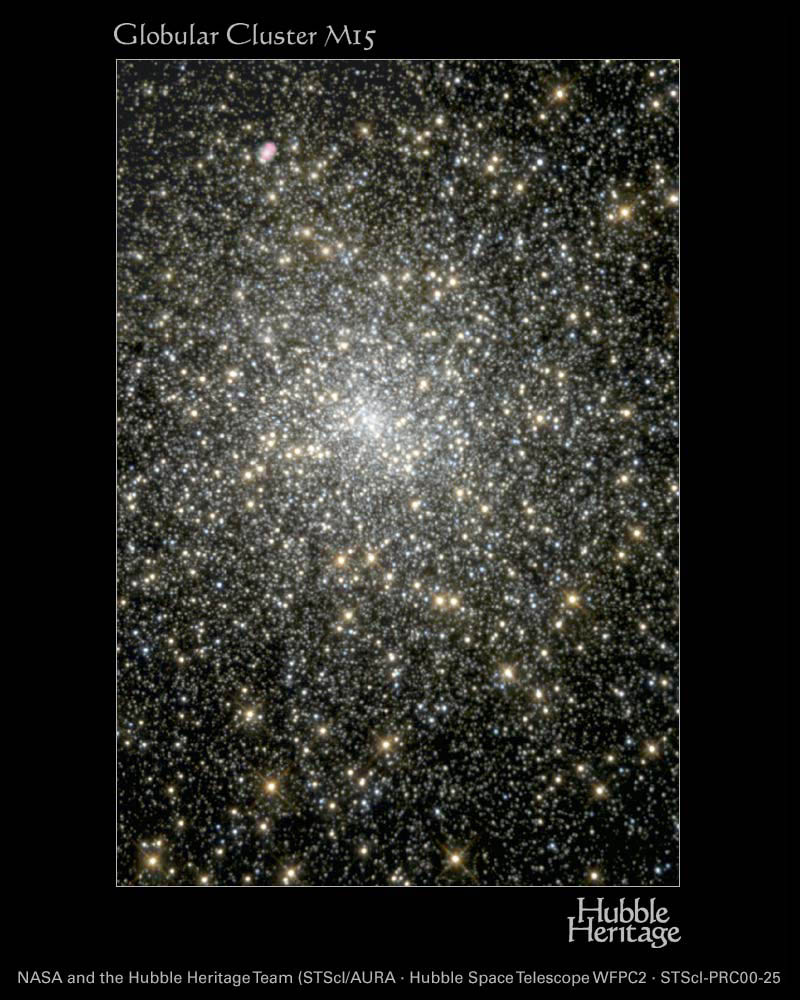
Caption: Globular cluster M15 (AKA NGC 7078, Great Pegasus Cluster) in constellation Pegasus at ∼ 11 parsecs (pc) from the Sun. The image is from the Hubble Space Telescope (HST, 1990--2040?, d = 2.4 m, Cassegrain reflector).
Globular clusters are compact, dense, roughly spherically symmetric, gravitationally-bound systems of stars (HI-395).
They are one of the two types of star cluster. The other type is type open cluster.
Globular cluster can have from of order 20,000 to several million stars and their central concentrations have diameters of order to 5 to 25 pc.
Near the center of a globular cluster, there could be 10,000 stars per cubic parsec: the night sky would be ∼ 10 times brighter than a full moon.????
Features:
- In the Milky Way, there
are ∼ 160
globular clusters
and they are spread around in the
Galactic halo.
To be precise, circa 2024, there are/were 158 known globular clusters in the Milky Way (Paduano et al. 2024). There are an estimated 180± 20. The estimated undiscovered globular clusters are believed to hidden by the interstellar medium (ISM) (particularly interstellar dust in the Milky Way disk) (see Wikipedia: Globular clusters: History of Observations).
- Globular clusters are common
astronomical objects
in galaxies throughout
the observable universe.
They are NOT confined to galactic disks (e.g., the Milky Way disk) of disk galaxies (e.g., the Milky Way).
So their orbits about galaxy centers (roughly galaxy centers of mass) have all orientations.
In disk galaxies, they are commonly noticed in the galaxy stellar halo, just as for the Milky Way.
- Globular clusters
mostly consist of
Population II stars
with ages ∼ 13.4--11.5 Gyr (i.e., they formed
in cosmic time
0.4--2.3 Gyr after the Big Bang),
and they so are very old
(Wikipedia: Globular cluster: Formation;
Wikipedia: Globular cluster: Consequences;
"Fossil Star Clusters Reveal Their Age" (2015)).
As of 2025, the oldest known globular clusters are calculated to be 13.39(33) Gyr old (Valcin et al. 2025, "The Age of the Universe with Globular Clusters III: Gaia distances and hierarchical modeling").
Note the age of the observable universe = 13.797(23) Gyr (Planck 2018) and the age determinations for globular clusters is an important lower limit on the age of the observable universe.
However, though very old, it seems at present that most globular clusters formed after reionization era (AKA cosmic dawn: cosmic time ∼ 0.150--1 Gyr, z∈∼[6,20]), but maybe NOT the very oldest ones given the Valcin et al. 2025 results.
- Why did globular clusters
form only in the relatively young
observable universe before
cosmic noon (z≅2, cosmic time ∼ 4 Gyr; lookback time ∼ 10 Gyr)?
Well,
globular cluster formation
is still NOT well known.
It may be that the low metallicity
of their formation era favored their formation whereas in later
times open clusters were favored.???
- Most stars
in globular clusters
formed at the same time over a span of ∼ 30 Myr ????.
However, most
globular clusters
have younger populations of
stars.
Possibly encounters and mergers ??? with
giant molecular clouds (GMCs)
triggered renewed bursts of
star formation
(Wikipedia: Globular cluster: Formation).
- The image is
approximately true color, though
the colors may be a bit enhanced.
There are numerous foreground stars which are recognizable by their 4-point diffraction patterns. We see the diffraction patterns because these stars have high apparent brightness compared to the M15 stars and were overexposed in obtaining a deep (i.e., faint-going) image of M15. The foreground stars also look mostly yellow for some reason???.
The small pink nebula in the upper left is a planetary nebula called Kuestner 648. It was the first planetary nebula discovered in a globular cluster. The discoverer was Francis Gladheim Pease (1881--1938) in 1928 (see Wikipedia: Messier 15: Characteristics). There are still only a few other planetary nebulae known in globular clusters.
Download site: NASA, The Hubble Heritage Team (STScI/AURA) Acknowledgment: H. Bond (STScI).
Image link: Itself.
Local file: local link: globular_cluster.html.
File: Star file: globular_cluster.html.